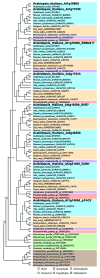PPR-SMRs: ancient proteins with enigmatic functions
- PMID: 24004908
- PMCID: PMC3858433
- DOI: 10.4161/rna.26172
PPR-SMRs: ancient proteins with enigmatic functions
Abstract
A small subset of the large pentatricopeptide repeat (PPR) protein family in higher plants contain a C-terminal small MutS-related (SMR) domain. Although few in number, they figure prominently in the chloroplast biogenesis and retrograde signaling literature due to their striking mutant phenotypes. In this review, we summarize current knowledge of PPR-SMR proteins focusing on Arabidopsis and maize proteomic and mutant studies. We also examine their occurrence in other organisms and have determined by phylogenetic analysis that, while they are limited to species that contain chloroplasts, their presence in algae and early branching land plant lineages indicates that the coupling of PPR motifs and an SMR domain into a single protein occurred early in the evolution of the Viridiplantae clade. In addition, we discuss their possible function and have examined conservation between SMR domains from Arabidopsis PPR proteins with those from other species that have been shown to possess endonucleolytic activity.
Keywords: Arabidopsis thaliana; Zea mays; chloroplast; endonuclease; genomes uncoupled; mitochondria; pentatricopeptide repeat protein; plastid; small MutS-related domain.
Figures



Similar articles
-
Unexpected functional versatility of the pentatricopeptide repeat proteins PGR3, PPR5 and PPR10.Nucleic Acids Res. 2018 Nov 2;46(19):10448-10459. doi: 10.1093/nar/gky737. Nucleic Acids Res. 2018. PMID: 30125002 Free PMC article.
-
Moss PPR-SMR protein PpPPR_64 influences the expression of a psaA-psaB-rps14 gene cluster and processing of the 23S-4.5S rRNA precursor in chloroplasts.Plant Mol Biol. 2021 Nov;107(4-5):417-429. doi: 10.1007/s11103-020-01090-z. Epub 2020 Oct 31. Plant Mol Biol. 2021. PMID: 33128724
-
Mutation of the pentatricopeptide repeat-SMR protein SVR7 impairs accumulation and translation of chloroplast ATP synthase subunits in Arabidopsis thaliana.J Plant Res. 2013 May;126(3):403-14. doi: 10.1007/s10265-012-0527-1. Epub 2012 Oct 18. J Plant Res. 2013. PMID: 23076438
-
Mechanistic insight into pentatricopeptide repeat proteins as sequence-specific RNA-binding proteins for organellar RNAs in plants.Plant Cell Physiol. 2012 Jul;53(7):1171-9. doi: 10.1093/pcp/pcs069. Epub 2012 May 9. Plant Cell Physiol. 2012. PMID: 22576772 Review.
-
The Enigmatic Roles of PPR-SMR Proteins in Plants.Adv Sci (Weinh). 2019 May 6;6(13):1900361. doi: 10.1002/advs.201900361. eCollection 2019 Jul 3. Adv Sci (Weinh). 2019. PMID: 31380188 Free PMC article. Review.
Cited by
-
Genome-wide investigation and expression analyses of the pentatricopeptide repeat protein gene family in foxtail millet.BMC Genomics. 2016 Oct 28;17(1):840. doi: 10.1186/s12864-016-3184-2. BMC Genomics. 2016. PMID: 27793078 Free PMC article.
-
Editing of Mitochondrial Transcripts nad3 and cox2 by Dek10 Is Essential for Mitochondrial Function and Maize Plant Development.Genetics. 2017 Apr;205(4):1489-1501. doi: 10.1534/genetics.116.199331. Epub 2017 Feb 17. Genetics. 2017. PMID: 28213476 Free PMC article.
-
A Plastid-Localized Pentatricopeptide Repeat Protein is Required for Both Pollen Development and Plant Growth in Rice.Sci Rep. 2017 Sep 13;7(1):11484. doi: 10.1038/s41598-017-10727-x. Sci Rep. 2017. PMID: 28904339 Free PMC article.
-
The GENOMES UNCOUPLED1 protein has an ancient, highly conserved role but not in retrograde signalling.New Phytol. 2022 Oct;236(1):99-113. doi: 10.1111/nph.18318. Epub 2022 Jul 5. New Phytol. 2022. PMID: 35708656 Free PMC article.
-
PPR-SMR1 is required for the splicing of multiple mitochondrial introns, interacts with Zm-mCSF1, and is essential for seed development in maize.J Exp Bot. 2019 Oct 15;70(19):5245-5258. doi: 10.1093/jxb/erz305. J Exp Bot. 2019. PMID: 31257441 Free PMC article.
References
Publication types
MeSH terms
Substances
LinkOut - more resources
Full Text Sources
Other Literature Sources
